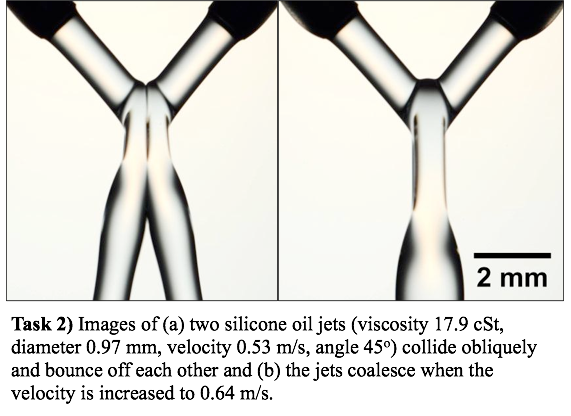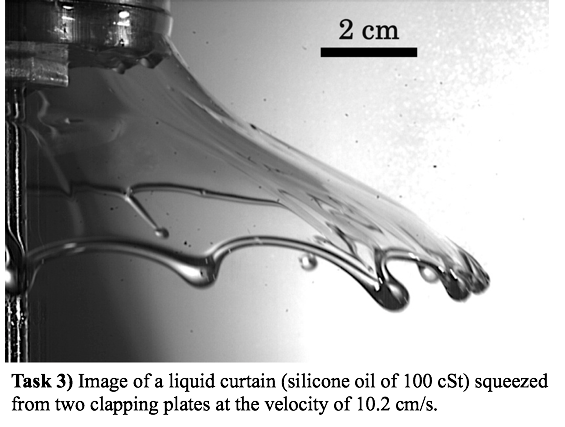58th Annual Report on Research 2013 Under Sponsorship of the ACS Petroleum Research Fund
Reports: DNI952332-DNI9: Multi-Scale Hydrodynamics of Bubble-Particle Interaction
Sunghwan Jung, Virginia Polytechnic Institute and State University
Annual Report (PRF# 52332-DNI9)
A bubble-particle interaction and interfacial fluid dynamics play important roles in understanding multiphase flows occurring in many industrial processes like petroleum purification processes. Our studies integrated experimental and theoretical approaches to explore these specific tasks: 1) Understand how a macroscopic bubble interacts with a particle, 2) determine the condition for interfaces to coalesce or bounce, and 3) understand the dynamics of a thin liquid film.
Task 1) Bubble-particle interaction in a thin fluid (Hele-Shaw) cell [On-going project]
In this task, we investigate how a bubble interacts with a particle at different speeds, angles, and sizes. For a better control of an experiment, a thin fluid chamber (often called a Hele-Shaw cell) is designed for a bubble and a particle to travel in a quasi 2D space. We examined the dynamics that a single bubble interacts with a small particle.
In preliminary results, we have observed two different states: one penetrating state and the other sliding state. The penetrating state is when a particle pierces through a bubble and eventually breaks into two daughter bubbles. The sliding state is a particle slides on the side of bubble without a penetration. The particle is attached to the bubble likely in the sliding state, but is possibly detached again depending on the relative speed of collision. Transition from the sliding to the penetration states is dictated by a Weber number (a ratio of inertia to surface tension) and an impact location as illustrated in the figure.
Task 2) Non-Coalescence & coalescence fluids [Published in Physical Review Letters, 2013]
When two fluid jets collide, they can bounce off each other, due to a thin film of air which keeps them separated. We describe the stable non-coalescence phenomenon between two jets of the same fluid, colliding obliquely with each other. Using a simple experimental setup, we carry out a parametric study of the bouncing jets by varying the jet diameter, velocity, collision angle, and fluid viscosity, which suggests that the contact time of bouncing jets scales as the square root of the normal Weber number (We). A dimensionless parameter K = (We (Re)1/2 / sin 𝛼)1/2, where Re is the normal Reynolds number and the collision angle of the jets, quantitatively captures the transition of colliding jets from bouncing to coalescence. This parameter draws parallels between jet coalescence and droplet splashing, indicating that the transition is governed by a surface instability. Stable and continuous non-coalescence between fluid jets makes it a good platform for experimental studies of the interaction between fluid interfaces and the properties of interfacial dynamics.
Task 3) Squeezing thin fluids [Published in Physical Review E, 2013]
Droplets splash around when a fluid volume is quickly compressed. This phenomenon has been observed during common activities such as kids clapping with wet hands. The underlying mechanism involves a fluid volume being compressed vertically between two objects. This compression causes the fluid volume to be ejected radially and thereby generate fluid threads and droplets at a high speed. In this study, we designed and performed laboratory experiments to observe the process of thread and drop formation after a fluid is squeezed. A thicker rim at the outer edge forms and moves after the squeezing, and then becomes unstable and breaks into smaller drops. This process differs from previous well-known examples (i.e., transient crown splashes and continuous water bells) in aspects of transient fluid feeding, expanding rim dynamics, or sparsely distributed drops. We compared experimental measurements with theoretical models over three different stages; early squeezing, intermediate sheet-expansion, and later break-up of the liquid thread. In the earlier stage, the fluid is squeezed and its initial velocity is governed by the lubrication force. The outer rim of the liquid sheet forms curved trajectories due to gravity, inertia, drag, and surface tension. At the late stage, drop spacing set by the initial capillary instability does not change in the course of rim expansion, consequently final ejected droplets are very sparse compared to the size of the rim.
In this first year of the project, we have developed both experimental setups and computational models for coalescence and thin-film dynamics. We have focused on more fundamental aspects of multiphase flows. This ACS PRF helped us to understand the underlying fluid mechanics in multiphase fluids as the first step in proposed works. Moving to the next year, we will further design a series of experiments to explore various regimes of bubble-particle interactions.
This award supported two graduate students and two short-term postdoctoral researchers. One graduate student led one published article under the fund support, and the other student is currently working on the bubble-particle in a thin fluid cell and other experiments this coming year. Also, we attended national meetings and conferences to disseminate our results to scientific communities.
Copyright © 2014 American Chemical Society














